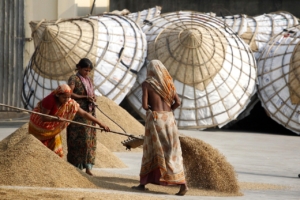 In 2025, Bhutan launched the Gelephu Mindfulness City, a $100 billion development project to bolster economic prosperity by focusing on spiritual well-being. The project’s primary goal is to reduce poverty and youth unemployment by building an international economic hub based on the principles of Bhutan’s unique philosophy of Gross National Happiness (GNH).
In 2025, Bhutan launched the Gelephu Mindfulness City, a $100 billion development project to bolster economic prosperity by focusing on spiritual well-being. The project’s primary goal is to reduce poverty and youth unemployment by building an international economic hub based on the principles of Bhutan’s unique philosophy of Gross National Happiness (GNH).
Renowned Danish sustainable architect Bjarke Ingels will design Gelephu Mindfulness City, which will span more than 2,000 square kilometers near Bhutan’s southern border with India. The project aims to transform the underdeveloped Gelephu region into a thriving center of sustainable commerce, cultural exchange and holistic living.
A Philosophy of Happiness Over Pure Growth
The project’s foundation lies in Bhutan’s GNH framework, which prioritizes psychological well-being, cultural preservation and environmental sustainability alongside traditional economic development. Rather than focusing solely on financial metrics like GDP, Bhutan uses GNH to measure societal success and quality of life.
“Happiness and well-being of people must be the purpose of capitalism,” said Bhutan Prime Minister Tshering Tobgay in conversation with TIME Magazine. “We are talking about creating a new paradigm, an entirely new system of urban development.” Gelephu Mindfulness City plans to advance all four pillars of GNH: sustainable development, environmental conservation, cultural preservation and good governance.
The project will employ green infrastructure, Buddhist architectural motifs, wellness centers and organic agriculture in all construction and community planning. This is part of a broader strategy to boost quality of life and address the root causes of poverty.
Job Creation Through Holistic Infrastructure
More young people are entering the workforce in Bhutan than the economy can absorb. Gelephu Mindfulness City aims to address this problem by creating thousands of jobs across construction, education, hospitality, agriculture and the wellness sector. The city will include schools and universities focused on sustainability, health and traditional knowledge. The plan aims to create short-term employment and long-term professional pathways for Bhutanese citizens.
The project also hopes to attract foreign direct investment through its designation as a Special Administrative Region. This status allows Gelephu to adopt more flexible policies and business regulations than the rest of Bhutan, to encourage ethical investment aligned with Bhutan’s values. The region will screen potential businesses and investors based on their respect for Bhutanese culture and commitment to sustainable and equitable development before extending an invitation to do business in the city.
Sustainability as an Economic Engine
Gelephu Mindfulness City plans to become a global blueprint for mindful urbanism, leveraging ecological integrity to increase economic inclusion. The city will feature renewable energy sources, pedestrian-first planning and strict limits on pollution. Organic markets and traditional healing centers will support local farmers and artisans, further stimulating small business development. These plans aim to attract climate-conscious businesses and tourists while preserving Bhutan’s pristine environment.
The emphasis on sustainability is particularly well-suited for the Gelephu region, a large flatland situated among the Himalayan foothills. Bhutan’s famously rugged terrain and limited industrial capacity render sustainable development the most viable long-term growth strategy. Sustainable transportation also plays a central role in the plans, with neighboring India committed to connecting border towns to the region via railway and improving roads in and out of Bhutan.
A Strong Likelihood of Success
Bhutan’s credibility in launching the Mindfulness City stems from its long-standing success in aligning development with environmental goals and overall well-being. The country is one of the few in the world that is carbon negative. Thanks to its vast forest cover, reliance on hydropower and constitutional mandate to maintain at least 60% forestation.
Past infrastructure projects have effectively incorporated eco-friendliness and community well-being principles, such as green schools and health initiatives emphasizing holistic care. These past successful initiatives demonstrate Bhutan’s capacity to balance modern development with its commitment to Gross National Happiness and provide a strong foundation for the ambitious goals set forth for Gelephu Mindfulness City.
A Blueprint for the Global South
Gelephu Mindfulness City provides a bold example of how low- and middle-income countries might reimagine development. Rather than regarding happiness and prosperity as unrelated metrics, Gelephu Mindfulness City treats them as inextricably intertwined. By reimagining capitalism and aligning economic goals with human well-being, Bhutan proposes a revolutionary mindset shift that could improve the lives of the 99% around the globe.
If successful, this model could inspire similar initiatives across the Global South, particularly in regions where conventional economic growth has failed to address deep-rooted inequalities. As Bhutan pushes forward with this ambitious project, it offers a fresh perspective on the fight against poverty: one that values sustainability, community and joy as invaluable elements of prosperity.
– Kelsey Eisen
Kelsey is based in San Francisco, CA, USA and focuses on Business and Politics for The Borgen Project.
Photo: Flickr


 In 2024, Catalonia launched one of Europe’s most ambitious
In 2024, Catalonia launched one of Europe’s most ambitious





